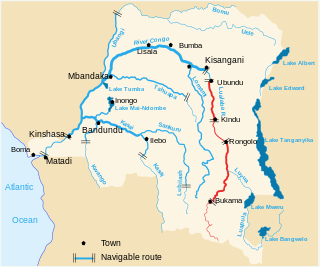Chiloglanis lufirae is a species of upside-down catfish endemic to the Democratic Republic of the Congo where it is found in the Lufira River drainage. This species grows to a length of 10 centimetres (3.9 in) SL.
Chiloglanis angolensis is a species of upside-down catfish endemic to Angola where it occurs in the Cuango River and the Rio Coroca. This species grows to a length of 5.6 centimetres (2.2 in) SL.
Chiloglanis benuensis is a species of upside-down catfish native to Cameroon and Nigeria where it occurs in the Niger, Bénoué and Chad River systems. This species grows to a length of 3.8 centimetres (1.5 in) TL.

Chiloglanis cameronensis is a species of upside-down catfish native to Cameroon, Equatorial Guinea and Gabon where they are found in the coastal rivers. This species grows to a length of 5.5 centimetres (2.2 in) TL.

Chiloglanis carnosus is a species of upside-down catfish endemic to the Democratic Republic of the Congo where it occurs in rapids of the lower Congo River. This species grows to a length of 6.1 centimetres (2.4 in) TL.
Chiloglanis congicus is a species of upside-down catfish endemic to the Democratic Republic of the Congo where it occurs in the lower Congo River basin. This species grows to a length of 7.5 centimetres (3.0 in) TL.
Chiloglanis disneyi is a species of upside-down catfish endemic to Cameroon where it is found in the Mungo and Manyu River basins. It may also occur in the Cross River basin of Nigeria. This species grows to a length of 3.5 centimetres (1.4 in) SL.
Chiloglanis elisabethianus is a species of upside-down catfish endemic to the Democratic Republic of the Congo where it occurs in the rivers of Katanga (province). This species grows to a length of 5.2 centimetres (2.0 in) TL.
Chiloglanis harbinger is a species of upside-down catfish endemic to Cameroon where it is found in the Lokunje River basin. This species grows to a length of 4.4 centimetres (1.7 in) SL.
Chiloglanis lamottei is a species of upside-down catfish native to Guinea, where it is found at Mount Nimba, and Côte d'Ivoire, where it occurs in the Cavally River. This species grows to a length of 5 centimetres (2.0 in) SL.
Chiloglanis lukugae is a species of upside-down catfish endemic to the Democratic Republic of the Congo where it is found in the Luvua River drainage. Reports from other locations need confirmation. This species grows to a length of 9 centimetres (3.5 in) SL.
Chiloglanis macropterus is a species of upside-down catfish endemic to Zambia where it occurs in the Luongo River. This species grows to a length of 9.8 centimetres (3.9 in) TL.
Chiloglanis marlieri is a species of upside-down catfish endemic to the Democratic Republic of the Congo where it occurs in the Ndakirwa River. This species grows to a length of 5.6 centimetres (2.2 in) TL.
Chiloglanis microps is a species of upside-down catfish endemic to the Democratic Republic of the Congo where it occurs in the Lufira River system. This species grows to a length of 5.6 centimetres (2.2 in) SL.
Chiloglanis niger is a species of upside-down catfish endemic to Cameroon where it occurs in the Niger River basin at Bamenda. This species grows to a length of 3.5 centimetres (1.4 in) SL.
Chiloglanis normani is a species of upside-down catfish endemic to Côte d'Ivoire where it occurs in the Cavally River system. This species grows to a length of 4.6 centimetres (1.8 in) SL.
Chiloglanis polyodon is a species of upside-down catfish endemic to Sierra Leone where it is only known from the headwaters of the Bagbwe River. This species grows to a length of 5.2 centimetres (2.0 in) TL.
Chiloglanis polypogon is a species of upside-down catfish endemic to Cameroon where it occurs in the Cross River. It may also occur in Nigeria. This species grows to a length of 5.5 centimetres (2.2 in) SL.
Chiloglanis sanagaensis is a species of upside-down catfish endemic to Cameroon where it is only found in the Sanaga River basin. This species grows to a length of 4.3 centimetres (1.7 in) SL.
Chiloglanis voltae is a species of upside-down catfish native to Burkina Faso, Cameroon, Ghana, Nigeria and Togo, where it occurs in the Volta and Bénoué River systems. This species grows to a length of 2.7 centimetres (1.1 in) TL.





